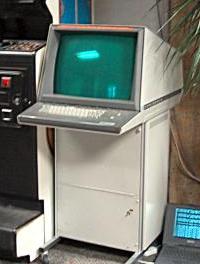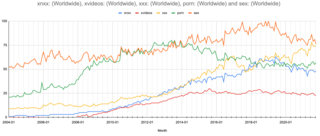Related Research Articles

ASCII, an acronym for American Standard Code for Information Interchange, is a character encoding standard for electronic communication. ASCII codes represent text in computers, telecommunications equipment, and other devices. Because of technical limitations of computer systems at the time it was invented, ASCII has just 128 code points, of which only 95 are printable characters, which severely limited its scope. Modern computer systems have evolved to use Unicode, which has millions of code points, but the first 128 of these are the same as the ASCII set.

ASCII art is a graphic design technique that uses computers for presentation and consists of pictures pieced together from the 95 printable characters defined by the ASCII Standard from 1963 and ASCII compliant character sets with proprietary extended characters. The term is also loosely used to refer to text-based visual art in general. ASCII art can be created with any text editor, and is often used with free-form languages. Most examples of ASCII art require a fixed-width font such as Courier for presentation.

A bulletin board system (BBS), also called a computer bulletin board service (CBBS), was a computer server running software that allowed users to connect to the system using a terminal program. Once logged in, the user can perform functions such as uploading and downloading software and data, reading news and bulletins, and exchanging messages with other users through public message boards and sometimes via direct chatting. In the early 1980s, message networks such as FidoNet were developed to provide services such as NetMail, which is similar to internet-based email.
Desktop publishing (DTP) is the creation of documents using dedicated software on a personal ("desktop") computer. It was first used almost exclusively for print publications, but now it also assists in the creation of various forms of online content. Desktop publishing software can generate page layouts and produce text and image content comparable to the simpler forms of traditional typography and printing. This technology allows individuals, businesses, and other organizations to self-publish a wide variety of content, from menus to magazines to books, without the expense of commercial printing.

A computer terminal is an electronic or electromechanical hardware device that can be used for entering data into, and transcribing data from, a computer or a computing system. Most early computers only had a front panel to input or display bits and had to be connected to a terminal to print or input text through a keyboard. Teleprinters were used as early-day hard-copy terminals and predated the use of a computer screen by decades. The computer would typically transmit a line of data which would be printed on paper, and accept a line of data from a keyboard over a serial or other interface. Starting in the mid-1970s with microcomputers such as the Sphere 1, Sol-20, and Apple I, display circuitry and keyboards began to be integrated into personal and workstation computer systems, with the computer handling character generation and outputting to a CRT display such as a computer monitor or, sometimes, a consumer TV, but most larger computers continued to require terminals.

The Minitel was a videotex online service accessible through telephone lines, and was the world's most successful online service prior to the World Wide Web. It was invented in Cesson-Sévigné, near Rennes, Brittany, France.
The computer art scene, or simply artscene, is the community interested and active in the creation of computer-based artwork.

The Tektronix 4010 series was a family of text-and-graphics computer terminals based on storage-tube technology created by Tektronix. Several members of the family were introduced during the 1970s, the best known being the 11-inch 4010 and 19-inch 4014, along with the less popular 25-inch 4016. They were widely used in the computer-aided design market in the 1970s and early 1980s.
ANSI art is a computer art form that was widely used at one time on bulletin board systems. It is similar to ASCII art, but constructed from a larger set of 256 letters, numbers, and symbols — all codes found in IBM code page 437, often referred to as extended ASCII and used in MS-DOS and Unix environments. ANSI art also contains special ANSI escape sequences that color text with the 16 foreground and 8 background colours offered by ANSI.SYS, an MS-DOS device driver loosely based upon the ANSI X3.64 standard for text terminals. Some ANSI artists take advantage of the cursor control sequences within ANSI X3.64 in order to create animations, commonly referred to as ANSImations. ANSI art and text files which incorporate ANSI codes carry the de facto.ANS file extension.
An output device is any piece of computer hardware that converts information or data into a human-perceptible form or, historically, into a physical machine-readable form for use with other non-computerized equipment. It can be text, graphics, tactile, audio, or video. Examples include monitors, printers, speakers, headphones, projectors, GPS devices, optical mark readers, and braille readers.

The VT50 is a CRT-based computer terminal that was introduced by Digital Equipment Corporation (DEC) in July 1974. It provided a display with 12 rows and 80 columns of upper-case text, and used an expanded set of control characters and forward-only scrolling based on the earlier VT05. DEC documentation of the era refers to the terminals as the DECscope, a name that was otherwise almost never seen.

Pornographic magazines or erotic magazines, sometimes known as adult magazines or sex magazines, are magazines that contain content of an explicitly sexual nature. Publications of this kind may contain images of attractive naked subjects, as is the case in softcore pornography, and, in the usual case of hardcore pornography, depictions of masturbation, oral, manual, vaginal, or anal sex.

The Teletype Model 33 is an electromechanical teleprinter designed for light-duty office use. It is less rugged and cost less than earlier Teletype models. The Teletype Corporation introduced the Model 33 as a commercial product in 1963, after it had originally been designed for the United States Navy. The Model 33 was produced in three versions:
A text game or text-based game is an electronic game that uses a text-based user interface, that is, the user interface employs a set of encodable characters, such as ASCII, instead of bitmap or vector graphics.

Page orientation is the way in which a rectangular page is oriented for normal viewing. The two most common types of orientation are portrait and landscape. The term "portrait orientation" comes from visual art terminology and describes the dimensions used to capture a person's face and upper body in a picture; in such images, the height of the display area is greater than the width. The term "landscape orientation" also reflects visual art terminology, where pictures with more width than height are needed to fully capture the horizon within an artist's view.
A web browser is a software application for retrieving, presenting and traversing information resources on the World Wide Web. It further provides for the capture or input of information which may be returned to the presenting system, then stored or processed as necessary. The method of accessing a particular page or content is achieved by entering its address, known as a Uniform Resource Identifier or URI. This may be a web page, image, video, or other piece of content. Hyperlinks present in resources enable users easily to navigate their browsers to related resources. A web browser can also be defined as an application software or program designed to enable users to access, retrieve and view documents and other resources on the Internet.

Extended ASCII is a repertoire of character encodings that include the original 96 ASCII character set, plus up to 128 additional characters. There is no formal definition of "extended ASCII", and even use of the term is sometimes criticized, because it can be mistakenly interpreted to mean that the American National Standards Institute (ANSI) had updated its ANSI X3.4-1986 standard to include more characters, or that the term identifies a single unambiguous encoding, neither of which is the case.
Amateur pornography is a category of pornography that features models, actors or non-professionals performing without pay, or actors for whom this material is not their only paid modeling work. Reality pornography is professionally made pornography that seeks to emulate the style of amateur pornography. Amateur pornography has been called one of the most profitable and long-lasting genres of pornography.

Internet pornography is any pornography that is accessible over the Internet; primarily via websites, FTP connections, peer-to-peer file sharing, or Usenet newsgroups. The greater accessibility of the World Wide Web from the late 1990s led to an incremental growth of Internet pornography, the use of which among adolescents and adults has since become increasingly popular.
The dark web is the World Wide Web content that exists on darknets: overlay networks that use the Internet but require specific software, configurations, or authorization to access. Through the dark web, private computer networks can communicate and conduct business anonymously without divulging identifying information, such as a user's location. The dark web forms a small part of the deep web, the part of the web not indexed by web search engines, although sometimes the term deep web is mistakenly used to refer specifically to the dark web.
References
- 1 2 Kerstin Mey, Art and Obscenity, I.B.Tauris, 2007, p155. ISBN 1-84511-235-0
- ↑ Annalee Newitz, On-the-go porn Archived January 15, 2009, at the Wayback Machine , salon.com, July 4, 2001.
- ↑ Cole, Samantha (January 14, 2019). "ASCII Pr0n Predates the Internet But it's Still Everywhere". www.vice.com. Retrieved 2022-02-26.
- ↑ such as for instance original IBM PCs with MDA cards
- ↑ Many early computer printers were either incapable of printing graphical images or required custom software support in every program to do so, which was not always implemented.
- ↑ Wagner, Karin (2023). "From ASCII Art to Comic Sands: Typography and Popular Culture in the Digital Age" (PDF). Watermark.SilverChair.com. The MIT Press. p. 29. Retrieved June 4, 2024.
- ↑ Kornelia Freitag, Katharina Vester, Another Language, LIT Verlag Berlin-Hamburg-Münster, 2008, pp. 102-3. ISBN 3-8258-1210-3